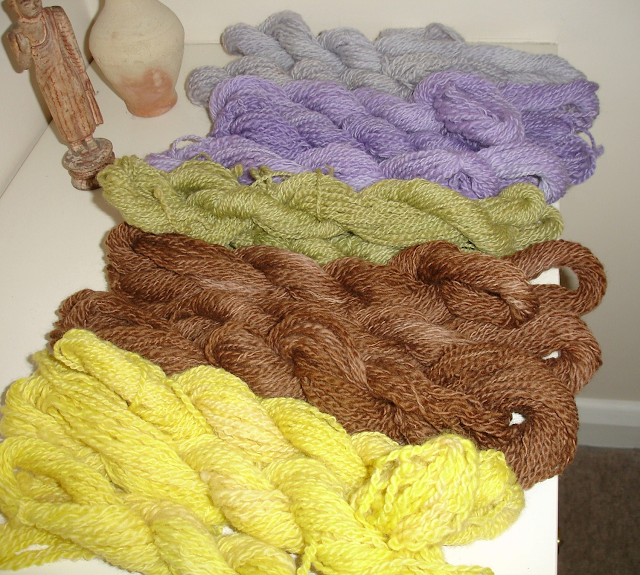Memories: F/B is good at finding your photos on its site. This one came up this morning. My dyeing of wools, the act of finding dye material, the mordant and then the final appearance of the wool. Natural dyes have a softer appeal than the chemical dyes. Looking at the photo, I think the brown is the only chemical dye. One of the 'magic' moments of dyeing with indigo is when you pull the wool from the dye bath as the material hits the air the oxygen turns the wool blue from the green. A sort of oh moment. You can see a full explanation here.
It is thought that in the Iron Age, the woad plant (Isatis Tinctoria) a species of the indigo family was used to colour the skin but of course none of that can be proved.
There is a chemical indigo now, growing the indigo woad plant, takes a full two years when the leaves are ready, and a steeping in urine was the preferred option in the olden days. Though wood ash can be used in the mordanting moment.
Thistles 2008: Even Moss lifts his leg with great delicacy against this thistle;)
Indigo: Then there is this from 2011, when I tried the artificial indigo
--------------------------------
And just to finish off a video of the process. Liziqi, the person who makes these videos of a farm idyll in China has somewhat disappeared off the radar but appears in other social media. She has/had millions of viewers to her videos, but obviously is doing something wrong the Chinese authorities think.
So another video here will show you how she dyes, firstly with the plants and secondly the application of wax on the material to create pattern.
What is interesting about this, is the similarity to the 'lost wax' techniques found in the making of metal objects. Wikipedia will fill you out here.





Wow! Thelma, I do not know how things are made like you do. I found that video so amazing. Such lovely fabrics.
ReplyDeleteWhat did you make with your dyed wool?
Mostly Ellen I make patchwork blankets when there is only a little of each colour but it was quite a while ago so can't remember. In fact it is the experiment that used to draw me to it.
DeleteGorgeous colours - both your wool and the fabric
ReplyDeleteI think the fabric is coloured in the patterned area of the material by wax. She definitely has a large wardrobe that young woman.
DeleteI thought of you. A spinning wheel went for $20 at the recent auction we attended.
ReplyDeleteI paid nearer £500 for my Australian Ashford spinning wheel, I like the wheel design, simple and uncluttered. Then made a mess of putting it together, so my daughter and I walked it through the streets to the Makery at the college where a couple of good men sorted it Debby.
DeleteI've done so much dyeing, with natural stuffs and chemicals. I've used chemical indigo (hated it), and never came across any natural dyestuff. Your yarns are lovely.
ReplyDeleteGetting the dye out of plants can sometimes be tricky Joanne, but the adding of mordants (chemical of course) such as alum or copper sulphate often gave different colours. And of course cochineal taken from the cochineal beetle gave a lovely range of reds.
DeleteMy favourite dye is the one that changes blue as soon as the air gets to it. Perhaps that's indigo. I did a couple of courses many years ago and found it all fascinating. Arilx
ReplyDeleteIt's definitely indigo Aril, when it hits the air, the dye oxygenates into blue. Problem with dyeing it needs equipment and a lot of space.
ReplyDelete